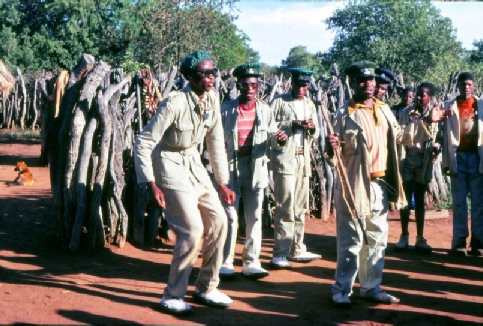© 2020 Dr Margaret Sheppard
This is the largest of the Zion Churches and is believed to be the forerunner. Its early history is fairly typical. During 1910-
Lekgonyane was led in his wanderings to a valley in Limpopo Province ( formerly North Eastern Transvaal) about 30 Km from Polokwane (formerly known as Pietersburg), the Byrne Valley. There he found a Holy Stone which was his confirmation that he had reached the end of his wanderings in the wilderness. Here he also found a Holy Mountain which he called Moria after Temple Mountain in Jerusalem, and for the remainder of his life he received visions from God. A town developed around the area, called after Moria the Holy Mountain. The total membership of the Z.C.C. in 1984 was reputed to be about 200,000. Local congregations try to make pilgrimages two or three times a year to Moria, which is considered a holy place.
There are two main branches of Z.C.C. churches: those that wear a silver badge in the shape of a star, and those that wear a badge in the shape of a bird. Both badges are attached to black ribbon.
The "bird" church was formally founded in 1924 by Bishop Engenas Lekgonyane. The other church -
However both churches are similar. In both the men wear khaki military-
The women wear their ordinary clothes, but always cover their hair at services and do not wear jewelry. They may also wrap around their ankles (up to the knees) seed pods strung together into dance rattles. These make a beautiful rhythmic sound during dancing which accompanies hymn singing.
The Z.C.C. is probably the largest independent church in Botswana, with branches throughout the country. The home of the Lekgonyanes at Moria is believed to be a Holy Place and the Lekgonyanes are believed to be intermediaries with God, rather like Badimo (Ancestors). Pilgrimages are made by congregations to Moria, especially at Easter and during the Botswana Independence holiday, and miracles are believed to happen there; cures, punishments etc.
Many of the articles used in the ritual at services are brought from Moria or have been specially prayed for there. For example little pieces of green paper with purple stripes that are burnt and dropped into water as part of the ritual to render it Holy, are from Moria, as are the special little cloths (rather like yellow dusters) that are used when rendering the water Holy or whilst praying on people. A short pole about six inches long, that is used by Prayers (Barapedi) whilst praying, is also obtained from Moria. At one Z.C.C. branch I saw a whip, like an ox whip, that was cracked to drive away lightning during a terrible thunder storm, and later held by the Moruti (Priest) in the centre during much of the service, this whip had been presented to that Moruti by the founder of the Z.C.C. and so was obviously much revered. Uniforms, badges and dance rattles may be prayed for at Moria before being issued to members.
Zion Christian Church (ZCC) - brief history




ZCC Men holding prophecy poles. N.B. ZCC badges in caps & khaki uniforms and outsized white hunter boots with car tyre soles.
Women members. N.B. seed pod dance rattles. The nights are cold during the all-